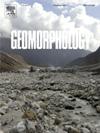巴塔哥尼亚北部Nahuel、Huapi-Limay和traul流域更新世冰川地貌和年代学
IF 3.1
2区 地球科学
Q2 GEOGRAPHY, PHYSICAL
引用次数: 0
摘要
纳维尔-华皮湖-利梅河流域和特拉尔河流域是巴塔哥尼亚北部第四纪冰川和环境变化重建的关键地区。这些遗址呈现出保存完好的冰川地貌;它们相对于安第斯山脉的位置使我们能够评估南西风对41°S过去气候的影响。为了完善该地区过去冰期的当地时间,我们提出了制图结果和14个来自不同冰碛系统的巨石的原位10Be暴露年龄,这些年龄反映了一系列明显的过去冰川推进。我们将我们的年龄限制与先前公布的重新计算的冰碛巨石年龄结合起来。地表暴露年龄表明,纳韦尔-华皮/利梅出口冰川在112.3±2.4 ka时接近末次冰旋回的最大值。这个年龄意味着冰川在末次冰期(海洋同位素阶段5d)开始的一个较冷的时期扩张,与全球冰量记录不一致,尽管不能排除这种扩张的年龄更大。我们认为,南西风的北移,加上降水的增加,可能是促成这种冰川推进的因素。末次盛冰期,纳huel河和trul河分别在26.8±1.4 ka和26.8±5.4 ~ 24.1±4.3 ka之间发生了一次较小范围的推进。本文章由计算机程序翻译,如有差异,请以英文原文为准。
Pleistocene glacial geomorphology and chronology of the Nahuel Huapi-Limay and Traful catchments, northern Patagonia
The Nahuel Huapi Lake-Limay River catchment and the Traful River catchment are key localities for reconstruction of Quaternary glaciations and environmental changes in northern Patagonia. These sites present very well preserved glacial landforms; their location with respect to the Andes mountains allows us to evaluate the influence of the Southern Westerly Winds on the past climate at 41°S. In an attempt to refine the local timing of past glaciations in this region, we present mapping results and fourteen in situ 10Be exposure ages from boulders of different moraine systems that reflect a series of pronounced past glacial advances. We combine our age constraints with recalculated previously published moraine boulder ages. The surface exposure ages suggest that the Nahuel Huapi/Limay outlet glacier reached positions close to its maximum extent of the last glacial cycle at 112.3 ± 2.4 ka. This age implies glacier expansion during a colder period at the beginning of the Last Glacial period (Marine Isotope Stage 5d), out of phase with global ice volume records, although an older age for this advance cannot be ruled out. We suggest that the northward migration of the Southern Westerly Winds, coupled with an increase in precipitation, could be contributing factors to this glacial advance. During the Last Glacial Maximum, a less-extensive advance occurred at 26.8 ± 1.4 ka in the Nahuel Huapi-Limay River catchment and between 26.8 ± 5.4 and 24.1 ± 4.3 ka in Traful River catchment.
求助全文
通过发布文献求助,成功后即可免费获取论文全文。
去求助
来源期刊

Geomorphology
地学-地球科学综合
CiteScore
8.00
自引率
10.30%
发文量
309
审稿时长
3.4 months
期刊介绍:
Our journal''s scope includes geomorphic themes of: tectonics and regional structure; glacial processes and landforms; fluvial sequences, Quaternary environmental change and dating; fluvial processes and landforms; mass movement, slopes and periglacial processes; hillslopes and soil erosion; weathering, karst and soils; aeolian processes and landforms, coastal dunes and arid environments; coastal and marine processes, estuaries and lakes; modelling, theoretical and quantitative geomorphology; DEM, GIS and remote sensing methods and applications; hazards, applied and planetary geomorphology; and volcanics.
 求助内容:
求助内容: 应助结果提醒方式:
应助结果提醒方式:


